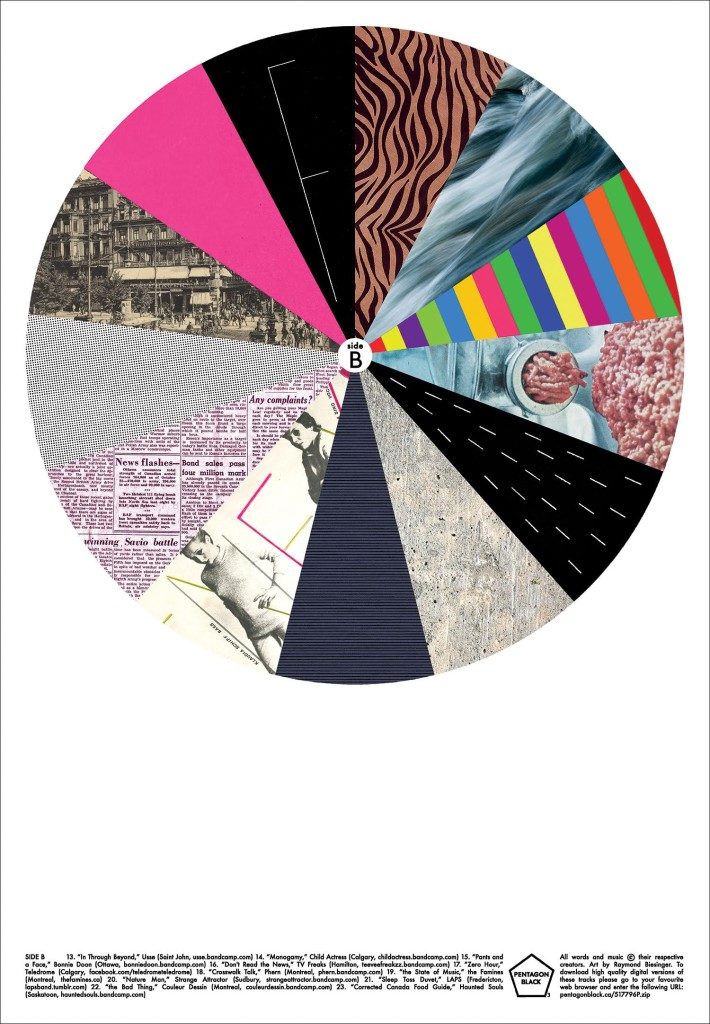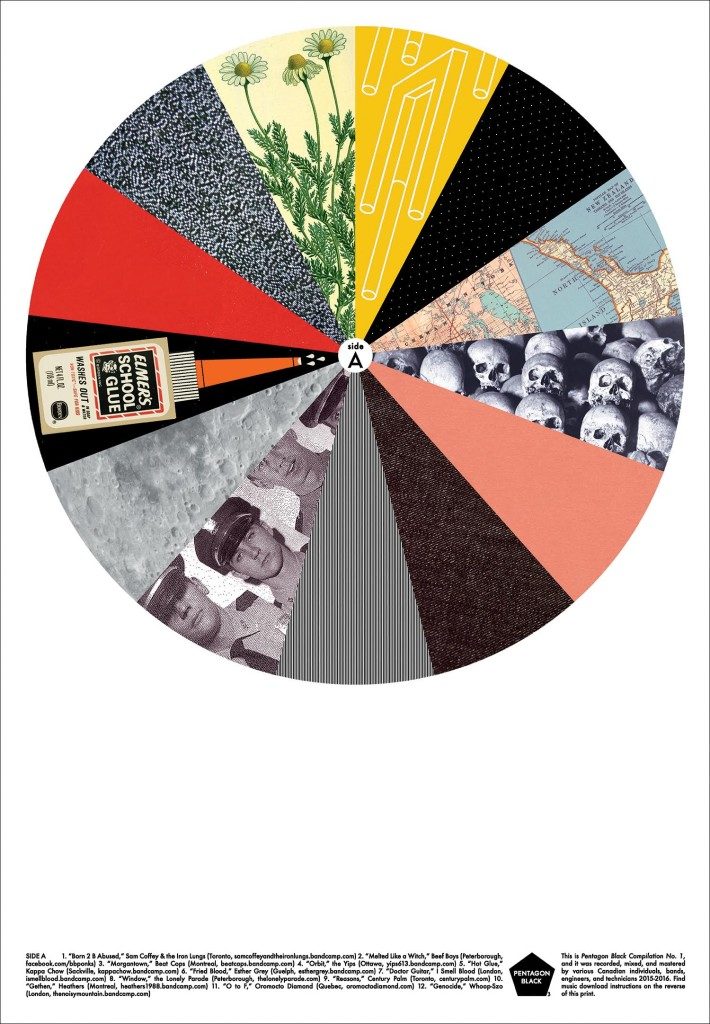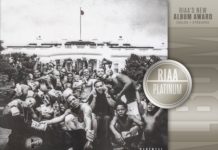
The new paper compilation aims to prove that underground music communities are more valuable than any publicist.
Can paper solve the music industry?
Last summer, The Famines found their solution to the gentrifying economy of physical music on newsprint. Now they’re hoping it can also solve the next 21st-century music problem: how to get people to listen to it.
Today, the Montreal punk band’s boutique record label/publishing arm Pentagon Black releases its first compilation. Pentagon Black Compilation No. 1 features original, never-before-heard songs from 23 “DIY-enthused” underground bands across Canada. It’s released on a double-sided 20×30″ newsprint poster with original art by Famines singer/guitarist Raymond Biesinger (one of Canada’s best illustrators) representing each song. Each copy comes with a download code, but it’s not streaming anywhere. In fact, the only way to get it is to show up to one of the participating bands’ shows and buy a copy.
Up until recently, that might not have seemed like such a wild idea for a band that exists primarily in bars and house parties, but when most music is announced with an exclusive premiere stream and an accompanying PR campaign, it’s a different path. This compilation has no press release and no advanced promo copies. In fact, until this morning, I was one of only two journalists who knew about it.
It’s definitely an experiment. Where record labels may not have the same power they once did in the indie sphere, publicists arguably have more. For instance, Biesinger and his Famines bandmate Drew Demers did a study of the November 2015 issue of Exclaim! and found that 93.5% of the bands covered had publicists. The bands on this compilation aren’t interested in playing that expensive game.
This, like many things that The Famines do, is by design. It’s tied into semi-tested ideas about where the engine of musical creativity and ingenuity is located — not with the paid gatekeepers in media and publicity firms, but the musicians themselves. Give the community something to rally behind and they’ll band together to spread the word themselves.
“Music is hard and nobody really has a solution,” says Biesinger. “There’s a certain decentralization of where music is going now, but the one thing we do know is that if someone wants to listen to this whole thing, they need to give a band $10. And that feels like an important thing at this time, when so many musicians are burning out or reducing the geography they can cover when touring, or touring less and spreading their art around less because the resources just aren’t there.”
Below is the full tracklist for Pentagon Black Compilation No. 1, followed by an expansive chat with Biesinger and Demers going in on the struggles of an underground band in the current music climate and how that informed this project.
Throughout this feature, you’ll also find debuts of songs by The Famines, Guelph band Esther Grey, and a music video by Peterborough’s The Lonely Parade (yes, we’re aware of the irony). Scroll to the bottom for a huge, still-growing list of all the Pentagon Black release shows from included bands at the end.

Raymond Biesinger: It all started last summer. We were increasingly frustrated because vinyl was becoming increasingly difficult. The price became so high and the Canadian exchange rate was so bad, and that prompted us experimenting with the paper single, which took advantage of very not in-demand newsprint printing process and the convenience of digital technology. When Mammoth Cave finally went out of business because of those same things, we just took control of our record and published the LP as the paper LP [Too Cool & Other Songs]. That affirmed for us the artist-friendly quality of releasing something on paper, or paper/digital.Later, Drew and I were in Rockton, Ontario, playing a festival called Strangewaves, surrounded by many, many, many, great bands, and we were debating what our next project would be. We had the idea of a split paper single, one band on one side, one band on the other, one being The Famines, and Drew and I almost came to blows over whether it would be with Century Palm or Kappa Chow on the other. Eventually we decided that because you can theoretically stick as many songs as you’d like onto one these things, we could have it all. We could expand this, and turn it into a two-dozen band compilation.
We talked to a few key bands about that and they expressed enthusiasm for the experiments of doing that, and the rest, well, you can listen to it.
How did you choose the bands that were on it?
Drew Demers: The initial ask was for roughly 48 bands, and that eventually whittled itself down to what we have on the compilation. A lot of times it was an easy decision for us based on the fact that the bands that we selected are very prominent in booking shows and promoting shows at their local level. For us, an important part of the decision was the accessibility of sharing shows. Since we started this project, we’ve linked together a lot of the bands that may not have known each other, but knew us, and they’ve actually started to play shows together.
And the idea was get a cross-section of Canada?
Drew Demers: We tried to. Western Canada right now I would say is the most under-represented on the compilation, which is something we definitely want to work after the next one. But, we’ve got bands spanning most of the Canadian provinces and that’s kind of what we wanted to do.
Another thing that we found very important was gender inclusivity. We wanted to make sure that there was a very high ratio of male to female. I’m not just talking all-female bands, but mixed gender bands and female bands. We didn’t want this to be just a bunch of white dudes rocking out.
Was everyone on board with the concept?
Raymond Biesinger: I think that most of the artists that are participating in this are feeling an incredible amount of frustration about releasing in conventional means. Putting out on vinyl is getting more and more difficult. I just read your article about the Inyrdisk closure. That [releasing on CD] doesn’t seem to be working for people anymore. The cassette thing, there’s been a lot of embracing of it, but I think the writing is on the wall for that as well. I think Urban Outfitters now sells cassettes, am I right? I’m sure it’s just a matter of time before there’s a backlash against that kind of thing.
I was thinking about how expensive this would be if it was an LP instead of a paper compilation. Between mailing out the copies, and the print run, which is now up to 800 copies, the pressing, the everything, I think it would probably cost 7 to 8 times as much to have done this via vinyl. Which, needless to say, is super prohibitive without incredible amounts of FACTOR funding and that kind of thing. With these bands, clearly the majority of them are not bands that are getting FACTOR funding, or who even really believe in dancing with the Canadian music industry.
I think this thing would be impossible if it wasn’t in this format. You know, to have some sort of physical manifestation, to have it be on such a large scale, to have it be so decentralized that every artist who’s participating has a large supply of them that they can spread around to their fans in this beautiful hand-to-hand way.
There’s so many release shows, too.
Raymond Biesinger: Yeah, and the most beautiful thing about those shows is that when we first sent out the first couple of emails, we were like, oh, if you want to set up a release show, by all means do it. And what is it, like, 18 or more of them have been set up? There are bands that are building tours around them. That’s beautiful, and it’s all on their initiative. We’ve supplied them with visual material for posters and images to promote, but otherwise it’s all their labour, and they’re very excited about it. The amount of enthusiasm among the bands has been really thrilling.
I imagine that’s part of the incentive is that you’re an artist and you’re creating original artwork for each of them.
Raymond Biesinger: For sure. As far as the art itself, it’s two circles, one for each side, divided into a couple dozen spots. We requested each band to give us a small amount of words that expressed what the song was about, what the band was about, almost to construct a word totem or a list of icons that encapsulates what the bands and the songs do. That was meant to help me do what I need to do as far as visuals go, and to make it as if the compilation is sort of this empty shell, and the collective identity of the compilation emerges from these individual identities rather than us imposing my style, visually, on the compilation.
That was interesting. It saved a lot of time, but also some of the images took like three of four different versions, multiple hours, and me pulling my hair out trying to figure it out, because bands sure love being contradictory, and they love abstract expressionism. I think the Sam Coffey image took me six hours to eventually arrive on a patch of denim, which is ridiculous. [laughing]
So this is an art project, but it’s also an economic solution. Can you separate out those two incentives?
Raymond Biesinger: Pentagon Black is clearly an extension of The Famines, and I know in the past that The Famines have done projects simply for art’s sake that had zero underpinning in economics. But as time went on, and we realized the grating effects of functioning the music economy, we realized that we needed to make sure that the projects we do are both artistically and economically sound. I think that just like the paper LP, this is kind of the perfect expression of that, but it also solves another problem: getting the word out. And we’re kind of allergic to the act of using a publicist.
You can put anything up on Bandcamp and people will hear it, but outside of your own personal attempts to try to get your friends, or their friends, to listen to it, how do people see it? Visibility is such a weird thing right now.
This project is so much about, simply, the beautiful purity of bands being enthused about each other and sharing their music with other people. Every one of these bands has strong incentive to spread around as many copies of these as possible, and financially it’s a good deal for them to do that, and artistically they’re enthused about it, and so that means that we’re all pushing this thing. I think that’s more valuable than any highly paid publicist. I think that’s important.
We did a study of the November 2015 issue of Exclaim! magazine and found that 93.5% of all of the articles in that magazine were reflecting on artists that were represented by paid publicists. We have no interest in doing that, and quite honestly we don’t have the means to do that. These artists too, the majority of them do not care for needing to pay money like that for exposure and would rather explore the idea of doing it ourselves and doing it as a community. I think that’s a big part of the enthusiasm that people have for this project.
So there’s a DIY element kind of baked into it.
Raymond Biesinger: One really funny moment was when I was talking with a contributor to the compilation, someone who’s been around a lot in Canadian and North American music. They had just put out a new record, and the publicist just dropped the ball hard, disappeared. He was very frustrated, sending out emails at the last minute, and getting no responses. So I expressed the publicity angle of this: we’re sending this to only two journalists because they’re people who have treated us with respect and have responded to us in a serious way in the past, and everyone else, we don’t care. This person just laughed and loved the idea.
Turning it around for once and not giving a shit about media is kind of a beautiful thing. To bring it all back to community and bands who like bands helping spread around band stuff, that’s beautiful.
And I can tell you that, from our side, that way of spreading is sometimes even more powerful than using a publicist, because people are more inclined to trust their friends.
Raymond Biesinger: Yeah, truly. It’s not lost on us when we’ve albums premiered or news being debut on any of the main music sites in Canada, the result is very paltry. This just seems more real.
The Famines song that’s included on this compilation, “The State of Music,” seems to be a concept song about, basically, everything we’re talking about. There’s also criticisms of things like the Polaris Prize, sponsored shows, grants, festivals with all-male lineups. “The state of music is unsound.”
Drew Demers: Yeah. I mean, the lyrics are very straightforward about a lot of our sentiments about the Canadian music industry, which is definitely not something we’re technically a part of. So, I mean, thematically, I would say that our song does express a lot of the opinions that a lot of the artists we’re working with want to express as well.
So the majority of the song is just kind of expressing disdain, and showing the pitfalls of how it works and the different difficulties that we face, and have kind of sworn off, when it comes to getting exposure from our music and trying to share it with people.
There’s that fun part in the song, “exposure kills, so play some more.” That’s the idea that so many artists get roped into, the idea that if you play at new music week, or CMJ, or NXNE kind of thing, playing for zero dollars to an empty room is going to advance your band in some sort of mythological way. It’s really not that way, at least not that we’ve experienced. So, this song is kind of poking fun at that.
SXSW doesn’t seem to be that thing anymore where a band is going to be discovered from playing a show. So does that exist anywhere? Or is it just online?
Drew Demers: We’re certainly at a crossroads right now. The modes are changing for that “discovery.” It used to be that Pitchfork was the be-all end-all, and once you a good review all of a sudden you were playing everywhere and everybody wanted to get your album and go to your shows. That’s waning. And as far as music bloggers, I feel like there’s more of a propensity towards Twitter in a lot of ways.
These old modes of the ways that bands used to get their music out has significantly changed. On one hand, you can put anything up on Bandcamp and people will hear it, but outside of your own personal attempts to try to get your friends, or their friends, to listen to it, how do people see it? Visibility is such a weird thing now.
I think that actually adds to the idea of this project. In a way, we’re helping expose the people who are enthusiastic about The Famines to some of the other artists on the compilation, just as much as their fanbases are now dipping their toes into our music as well. Specifically that’s people listening to the music, but at the same time, the only way to get a copy of this compilation is to go to a show and buy it directly from the artists. So that’s also helping those local scenes. That’s kind of our sneaky way of roping people to come out to shows.
You can get Pentagon Black’s Compilation No. 1 at one of the following release shows:














